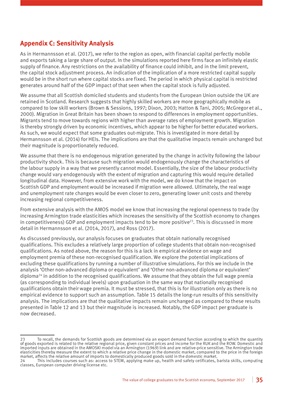
35
The value of college graduates to the Scottish economy, September 2017
Appendix C: Sensitivity Analysis
As in Hermannsson et al. (2017), we refer to the region as open, with financial capital perfectly mobile
and exports taking a large share of output. In the simulations reported here firms face an infinitely elastic
supply of finance. Any restrictions on the availability of finance could inhibit, and in the limit prevent,
the capital stock adjustment process. An indication of the implication of a more restricted capital supply
would be in the short run where capital stocks are fixed. The period in which physical capital is restricted
generates around half of the GDP impact of that seen when the capital stock is fully adjusted.
We assume that all Scottish domiciled students and students from the European Union outside the UK are
retained in Scotland. Research suggests that highly skilled workers are more geographically mobile as
compared to low skill workers (Brown & Sessions, 1997; Dixon, 2003; Hatton & Tani, 2005; McGregor et al.,
2000). Migration in Great Britain has been shown to respond to differences in employment opportunities.
Migrants tend to move towards regions with higher than average rates of employment growth. Migration
is thereby strongly driven by economic incentives, which appear to be higher for better educated workers.
As such, we would expect that some graduates out-migrate. This is investigated in more detail by
Hermannsson et al. (2014) for HEIs. The implications are that the qualitative impacts remain unchanged but
their magnitude is proportionately reduced.
We assume that there is no endogenous migration generated by the change in activity following the labour
productivity shock. This is because such migration would endogenously change the characteristics of
the labour supply in a way that we presently cannot model. Essentially, the size of the labour productivity
change would vary endogenously with the extent of migration and capturing this would require detailed
longitudinal data. However, from extensive work with the model, we do know that the impact on
Scottish GDP and employment would be increased if migration were allowed. Ultimately, the real wage
and unemployment rate changes would be even closer to zero, generating lower unit costs and thereby
increasing regional competitiveness.
From extensive analysis with the AMOS model we know that increasing the regional openness to trade (by
increasing Armington trade elasticities which increases the sensitivity of the Scottish economy to changes
in competitiveness) GDP and employment impacts tend to be more positive23. This is discussed in more
detail in Hermannsson et al. (2014, 2017), and Ross (2017).
As discussed previously, our analysis focuses on graduates that obtain nationally recognised
qualifications. This excludes a relatively large proportion of college students that obtain non-recognised
qualifications. As noted above, the reason for this is a lack in empirical evidence on wage and
employment premia of these non-recognised qualification. We explore the potential implications of
excluding these qualifications by running a number of illustrative simulations. For this we include in the
analysis 'Other non-advanced diploma or equivalent' and 'Other non-advanced diploma or equivalent'
diploma24 in addition to the recognised qualifications. We assume that they obtain the full wage premia
(as corresponding to individual levels) upon graduation in the same way that nationally recognised
qualifications obtain their wage premia. It must be stressed, that this is for illustration only as there is no
empirical evidence to support such an assumption. Table 15 details the long-run results of this sensitivity
analysis. The implications are that the qualitative impacts remain unchanged as compared to these results
presented in Table 12 and 13 but their magnitude is increased. Notably, the GDP impact per graduate is
now decreased.
23 To recall, the demands for Scottish goods are determined via an export demand function according to which the quantity
of goods exported is related to the relative regional price, given constant prices and income for the RUK and the ROW. Domestic and
imported inputs are obtained in the AMOSKI model via an Armington (1969) link and are relative-price sensitive. The Armington trade
elasticities thereby measure the extent to which a relative price change in the domestic market, compared to the price in the foreign
market, affects the relative amount of imports to domestically produced goods sold in the domestic market.
24 This includes courses such as: access to STEM, applying make up, health and safety cetificates, barista skills, computing
classes, European computer driving license etc.